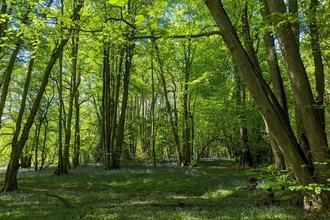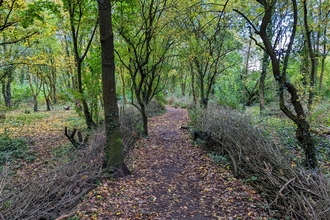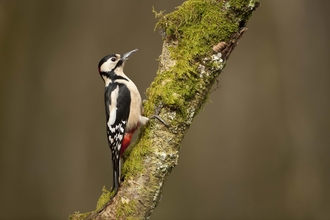Update: March 2023
Our woodland management work at Piles Coppice has now paused for bird nesting season.
Throughout the winter, we started sympathetic management work on the woodland and coppiced a small number of small-leaved lime trees on path edges. These trees were previously coppiced over 70 years ago and the work we have just completed will extend their life and prevent them from becoming unstable and breaking apart, which a few of the trees in the woodland have started to do. This work resets the clock and the tree stumps (or stools) will send up shoots that will grow larger and regenerate over time. As they regenerate, they will form a variety of canopy heights.
At the moment, the tree canopy in the woodland is all the same height, which is not helpful in promoting a woodland rich in wildlife. A canopy of only one height can support a limited number of species, but in order to encourage wildlife back to our woodlands, we need to reintroduce the traditional woodland management that was practised here for centuries.
This work has also created a small, sheltered pocket of light in the woodland, which will stimulate the growth of woodland plants, which in turn will benefit pollinating insects. The arrival of the pollinating insects will support other animal and bird life and the variety of wildlife in the woodland will start to grow.
As the trees regenerate, they create lower-level nesting and cover for more birds and small mammals, who don’t necessarily like to be at the top of the tree canopy.
The coppiced wood has all been left in the woodland, and once it rots down will form the future woodland soil, returning essential nutrients to the ground for new growth. This wood also creates essential cover and food for insects, beetles, fungus and much more – all these are essential in starting the wildlife lifecycle of the woodland, supporting and encouraging birds and mammals to call Piles Coppice their home.
We have completed similar work in other woodland areas, such as Ryton Wood, Wappenbury, Cock Robin Wood, Oakley Wood and Bubbenhall. Some of these are now the richest and most diverse woodlands in the area due to woodland management.
Sympathetic woodland management should not be feared or shied away from. It is essential to help the woodland thrive, to stop it becoming dark and over-crowded and to allow it to support a wide variety of plants and animals. It’s also essential to ensure the woodland survives for our children and their children’s children. It’s not just here for us, for now. We must think beyond our own lifetimes, which are a fleeting moment in time, when we consider that the life of a woodland can span centuries.
Our legacy must be better than what we inherited.
Piles Coppice
Piles Coppice is a mature woodland at Brandon Reach nature reserve. It is private land managed by Warwickshire Wildlife Trust with permitted public access. Brandon Reach officially opened as a nature reserve in 2019.
The site has a mosaic of habitats including open areas, wet woodland, scrub and ancient woodland. Unfortunately, the woodland habitats are reverting to an even-aged structure and closed canopy, with open areas filling with scrub due to lack of management. This is not optimal for wildlife.
Woodlands made up of similar sized and aged trees with little variation in tree species can only support a limited number of plant and animal species. By actively managing woodlands (and mimicking the natural processes that used to occur), through tree felling, coppicing, creating and cutting open areas and encouraging dead wood, we are able to create light and shade, wetter and drier areas and ensure varied structure to the woodland, which will support a much greater range of woodland species.
We are also protecting and enriching the woodlands for the future, by allowing space for the next generation of trees to replace those that exist now and by making them resistant to diseases and pests that target individual tree species.
All woodlands in the UK have been managed through felling trees at some stage in their life. Indeed, the reasons people and wildlife may benefit from a particular woodland could be due to the way it has been managed in its past. For example, large veteran oaks provide much visual and wildlife value, but would not exist without the felling of trees around them over their lifetime.
Our work aims to recreate the right conditions to prevent the further loss of wildlife. We want to enrich the wildlife in Piles Coppice. By creating woodland made up of trees of varying heights, ages and species we are creating a wide range of places where different plants and animals can thrive.
We are reintroducing traditional methods in Piles Coppice so that it can be healthy for years to come, by bringing less than 5% of the woodland into management.
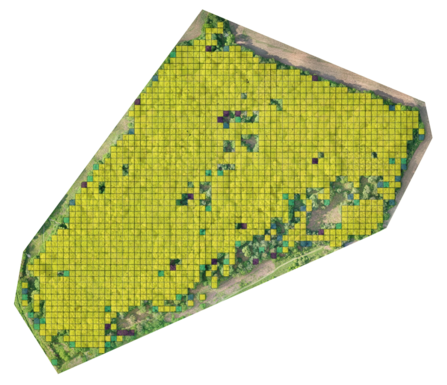
This image shows the results of a drone survey undertaken at Piles Coppice. You can see how few gaps in the canopy there are in the woodland, as yellow squares indicate areas with no gaps and a very high density of trees. This is not optimal for the health of the woodland.
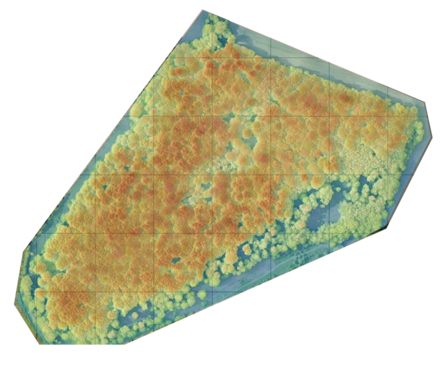
A second image from the drone survey showing the height of the tree canopy. As you can see, much of the woodland is a uniform orange-red indicating the many of the trees are a similar height and don't have much variation.
Why is variation important?
When woodlands have an uneven structure, there will be a mixture of different aged trees. This creates more different places for wildlife to live. It also allows the woodland to be more resilient to disease and environmental change, as the next generation of trees can grow up.
In an even-aged woodland, many of the trees are a similar age. This results in a woodland which looks 'neat and tidy' but which does not offer as many places for wildlife to live.

Under the canopy
As you can see in this photo, there is a large gap between the tree canopy (high up) and the woodland floor below. Because very little sunlight can filter through the leaves, it has created a 'dead zone' between the canopy and the ground where nothing can grow. This problem results from the trees being of a similar age and height, and means that there will not be many wildflowers or shrubs growing on the woodland floor to provide food and shelter for wildlife.
How can we improve the woodland, naturally?
Thinning out a small selection of trees, to provide light and space for older trees to grow, as well as helping younger trees to develop.
Coppicing lime, alder and hazel trees to encourage different levels of branch height. This supports a wider range of wildlife and helps to protect the ancient lime stools from breaking apart.
Managing track edges through repeated cutting to encourage a mixture of wildflowers and plant life.
Monitoring throughout the work to assess results of management work and inform future plans.
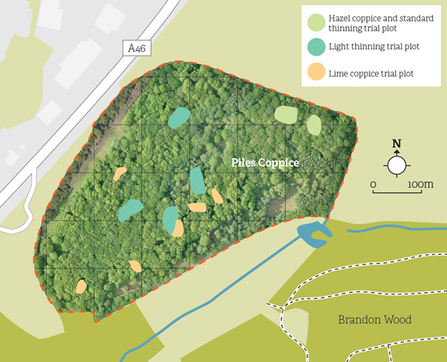
What will we do at Piles Coppice?
We are reintroducing management in the woodland so that it can be healthy for years to come.
- In the first year we will start to work on 12 small plots; bringing less than 5% of the woodland into management.
- We will use a mixture of traditional light thinning, lime coppicing, and hazel coppicing to manage the woodland.
- Where plots meet track edges, vegetation growth will be managed to improve structure.
- Hand felling will be performed, with dead wood left on site for wildlife.
- Some plots will be protected from deer damage with fencing.
- Results will be monitored for at least five years before any further plans formulated.

Phase 2 Plans - Brandon Reach and Minimum Intervention Areas
To maintain the overall health of the nature reserve, we will:
- Perform selective thinning and coppicing over a 10 year period.
- Where ash trees are found in abundance, favour alternative species and vigorous ash to reduce the risk from ash dieback disease.
- Retain ash saplings in case of resistance to ash dieback disease.
- Operate minimum intervention zones, where the woodland is already healthy, which will only be managed for health and safety.
Not all areas of the nature reserve will be managed, only those necessary to maintain the health of the site.

